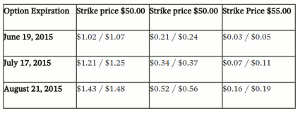Elvis Picardo of Investopedia.com outlines the pluses and minuses of writing calls on high dividend-paying stocks. Though it could boost portfolio returns, it may not be right for option traders who believe the risk of these stocks being called is not worth the modest premium received.
Writing calls on stocks owned in a portfolio—a tactic known as covered call writing—is a viable strategy that can be effectively used to boost returns on a portfolio. Writing covered calls on stocks that pay above-average dividends is a subset of this strategy. Let's illustrate the concept with the help of an example.
Example
Consider a covered call on telecom giant Verizon Communications, Inc. (VZ), which closed at $50.03 on April 24, 2015. Verizon pays a quarterly dividend of $0.55, for an indicated dividend yield of 4.4%.
The Table shows option premiums for a marginally in-the-money call ($50 strike price) and two out-of-the-money calls ($52.50 and $55 strikes), expiring in June, July, and August. Note the following points:
Call Option Pricing for Verizon
- For the same strike price, the call premiums increase the further out you go. For the same expiration, the premiums decrease as the strike price increases. Determining the appropriate covered call to write is thus a tradeoff between the expiration and strike price.
- In this case, let's say we decide on the $52.50 strike price, since the $50 call is already slightly in-the-money (which increases the likelihood that the stock may be called before expiration), while the premiums on the $55 calls are too low to warrant our interest.
- Since we are writing calls, the bid price must be considered. Writing the June $52.50 calls will provide premium of $0.21 (or approximately 2.7% annualized), while the July 17 calls fetch a premium of $0.34 (2.9% annualized) and the August 21 calls give premium of $0.52 (3.2% annualized).
Annualized premium (%) = (option premium x 52 weeks x 100) / stock price x weeks left for expiration.
- Each call option contract has 100 shares as the underlying. Assume you buy 100 shares of Verizon at the current price of $50.03 and write the August $52.50 calls on these shares. What would be your return if the stock rises above $52.50 just before the calls expire and is called? You would receive the $52.50 price for the stock if it is called, and would also have received one dividend payment of $0.55 on August 1. Your total return is therefore:
($0.55 dividend received + $0.52 call premium received + $2.47 *) / $50.03 = 7.1% in 17 weeks. This equates to an annualized return of 21.6%.
* $2.47 is the difference between the price received when the stock is called, and the initial purchase price of $50.03.
If the stock does not trade above the strike price of $52.50 by August 21, the calls expire unexercised and you retain the premium of $52 ($0.52 x 100 shares) less any commissions paid.
Pros and Cons
Opinion seems to be divided on the wisdom of writing calls on stocks with high-dividend yields. Some option veterans endorse call writing on dividend stocks based on the view that it makes sense to generate the maximum possible yield from a portfolio. Others contend that the risk of the stock being called away is not worth the measly premiums that may be available from writing calls on a stock with a high-dividend yield.
Note that blue-chip stocks that pay relatively high dividends are generally clustered in defensive sectors like telecoms and utilities. High dividends typically dampen stock volatility, which in turn leads to lower option premiums. In addition, since a stock generally declines by the dividend amount when it goes ex-dividend, this has the effect of lowering call premiums and increasing put premiums. The lower premium received from writing calls on high-dividend stocks is offset by the fact that there is a reduced risk of them being called away (because they are less volatile).
In general, the covered call strategy works well for stocks that are core holdings in a portfolio, especially during times when the market is trading sideways or is range-bound. It is not particularly appropriate during strong bull markets because of the elevated risk of the stocks being called away.
The Bottom Line
Writing calls on stocks with above-average dividends can boost portfolio returns. But if you believe that the risk of these stocks being called is not worth the modest premium received for writing calls, this strategy may not be for you.
Disclosure: The author did not hold positions in any of the securities mentioned in this article at the time of publication.
By Elvis Picardo, Contributor, Investopedia.com






















